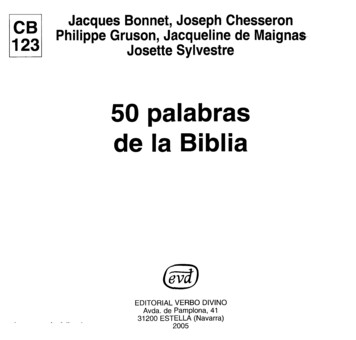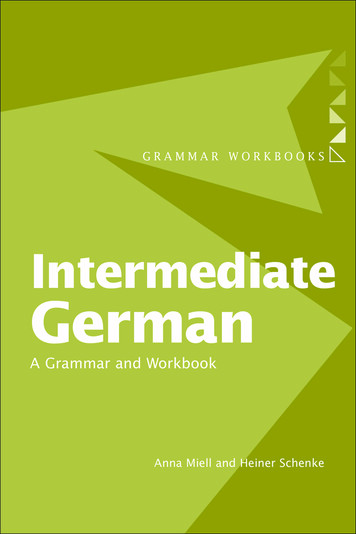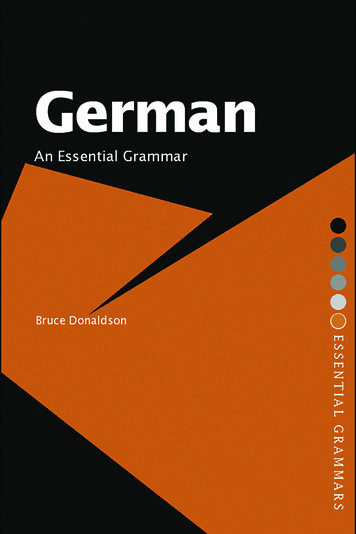
Transcription
ModernGERMANGrammarSecond Edition
Routledge Modern GrammarsSeries concept and development – Sarah ButlerOther books in the series:Modern French GrammarModern Italian GrammarModern Spanish Grammar, Second EditionModern French Grammar WorkbookModern Italian Grammar WorkbookModern Spanish Grammar Workbook, Second Edition
ModernGERMANGrammarA practical guideSecond EditionBill Dodd, Christine Eckhard-Black, John Klapper,Ruth Whittle
First published in 1996by RoutledgeSecond edition first published in 2003by Routledge11 New Fetter Lane, London EC4P 4EESimultaneously published in the USA and Canadaby Routledge29 West 35th Street, New York, NY 10001Routledge is an imprint of the Taylor & Francis GroupThis edition published in the Taylor & Francis e-Library, 2005.“To purchase your own copy of this or any of Taylor & Francis or Routledge’scollection of thousands of eBooks please go to www.eBookstore.tandf.co.uk.” 1996, 2003 Ruth Whittle, Christine Eckhard-Black, John Klapper, Bill DoddAll rights reserved. No part of this book may be reprinted orreproduced or utilized in any form or by any electronic,mechanical, or other means, now known or hereafterinvented, including photocopying and recording, or in anyinformation storage or retrieval system, without permission inwriting from the publishers.British Library Cataloguing in Publication DataA catalogue record for this book is available from the British LibraryLibrary of Congress Cataloging in Publication DataModern German grammar : a practical guide / Bill Dodd . . . [et al.]. – 2nd ed.p.cm. – (Routledge modern grammars)Includes index.1. German language – Grammar.foreign speakers – English.PF3112.M552. German language – Textbooks forI. Dodd, Bill (Bill J. ), 1950–.II. Series.2003438.2′421 – dc21ISBN 0-203-42829-3 Master e-book ISBNISBN 0-203-44053-6 (Adobe eReader format)ISBN 0–415–27299–8 (hbk)ISBN 0–415–27300–5 (pbk)2002155517
ContentsIntroductionHow to use this bookGlossaryixxixiiiPART A StructuresI Letters and sounds1 Vowels2 Diphthongs3 Consonants4 Stressv33445II Word order5 Simple sentences and main clauses6 Two main clauses7 Direct questions and commands8 Subordinate clauses9 Indirect questions10 Relative clauses11 Order of adverbials12 Noun and pronoun objects13 Position of nicht14 Position of reflexive pronouns15 Flexible word order and emphasis779101114141617181920III161718192021The case systemThe casesThe nominativeThe accusativeThe dativeThe he articleUse of the articlesDeterminersGenderCompound nouns and acronyms363637414347
CONTENTS27 Gender variations28 Noun declensions29 Plurals474850V Pronouns30 Pronoun reference and forms31 Other forms used as pronouns32 Pronouns used after erb formsUse of tensesModal verbsSeparable and inseparable verbsReflexive verbsPrepositional verbsThe subjunctiveThe passiveImperativesBasic sentence patterns: verbs and their completion5959717481879093102105107VII Adjectives and adverbs43 Predicative and attributive adjectives44 Declension following der etc.45 Declension following ein etc.46 ‘Zero’ declension47 Other adjective types48 Comparison of adjectives49 Extended adjectival phrases50 Adverbs51 Comparison of adverbs118118118120121123125129129132VIII Word structure and word formation52 Principles of word formation53 Forming verbs54 Forming nouns55 Forming adjectives56 Forming adverbs57 The meaning of verbal prefixes134134135135139141142IX Style and orthography58 Formal and informal style59 Spelling and punctuation146146148
ContentsPart B FunctionsviiX Social contact60 Greeting61 Making introductions62 Taking leave63 Eating and drinking64 Giving and receiving compliments65 Expressing commiseration66 Expressing good wishes67 Giving and receiving thanks, expressing appreciation68 Expressing apologies and 75767778Giving and seeking factual informationTalking and enquiring about existenceTalking and enquiring about absence and non-existenceExpressing and enquiring about availabilityTalking about non-availabilityIdentifying and seeking identificationDescribing peopleDescribing objectsDescribing actions and processesAvoiding describing the agent of processes and actionsDescribing origins and provenance211211215221224227231241252267269XII Putting events into a wider context79 Giving reasons and purpose80 Providing spatial context81 Providing temporal context82 Talking about cause and effect83 Drawing conclusions with reference to sources84 Referring to sources of information85 Reporting other people’s words and claims86 Expressing necessity87 Expressing ability to do something88 Conveying doubt and certainty89 Expressing assumptions, discussing possibility, probabilityand conditions274274281286296300303307309317319XIII Transactions: getting things done90 Attracting attention91 Helping and advising92 Asking for something to be done93 Expressing needs, wishes and desires325325328333336322
109110111112113114115Expressing objections and complaintsGiving and seeking promises and assurancesIssuing, accepting and declining invitations and offersSeeking, granting and denying permissionMaking, accepting and declining suggestionsIssuing and responding to warnings339346349353356358Conveying attitudes and mental statesAsserting and denying the truth of somethingExpressing knowledgeRemembering and forgettingExpressing future intentionsExpressing likes and dislikes: people, things and situationsIndicating preferencesExpressing indifferenceVoicing opinionExpressing firm convictionsExpressing agreement and disagreementTalking about physical well beingExpressing happiness, fear and sadnessExpressing satisfaction and dissatisfactionExpressing hopes, wishes and disappointmentExpressing surpriseExpressing enjoyment and 404409412XV Communication strategies116 Using fillers117 Keeping the channel open118 Asking for spoken linguistic cues119 Shaping the course of a conversation120 Turn-taking in conversations121 Delivering monologues (formal speaking)416416418425427432435Index441viii
IntroductionModern German Grammar. A Practical Guide is an innovative reference grammar designedto be used with modern approaches to teaching and learning German as a foreignlanguage. The book addresses learners’ practical needs by combining a detaileddescription of the grammatical structures of German with a ‘functional’ approach tolanguage. By functions we mean the specific uses to which we can put language inorder to communicate effectively in particular situations: e.g. apologizing, acceptingor declining an invitation, expressing regret, voicing an opinion or casting doubt onsomething.The book is intended for all those who have a basic knowledge of German, includingundergraduates taking German as a major or minor part of their studies, as well asintermediate and advanced students in both schools and adult education. It will alsoprove an invaluable resource for teachers seeking back-up to syllabuses organizedaround functions, or designers of German language courses and syllabuses in allsectors of education.Before using the book the reader is advised to refer to pp. xi–xii on ‘How to use thisbook’. There are two main parts. Part A (sections 1–59) provides a detailed descriptionof the structures of modern German, and is in this respect quite close to being a‘traditional’ grammar. The explanations given in Part A are supported by a detailedglossary of grammatical terms which assumes no previous grammatical training. Incontrast, the larger Part B (sections 60–121) focuses on functions, explaining andillustrating the appropriate use of German in particular contexts, the specific ideas thelearner wishes to express and the concrete situations in which he or she is likely to wishto use them.There is a comprehensive index at the back of the book. This is a very importantsection as the detailed entries on functions, structures and grammatical terminologyallow the reader to approach the language in more than one way: he or she can eitherlook up how to express a particular function or seek information on how a certainaspect of the language works. Having located the required function (e.g. ‘Attractingattention in a dangerous situation’ 90.1), the learner is referred to relevant structuresin Part A (e.g. ‘Use of Subjunctive II’). This approach avoids the difficulties learnershave with traditional grammars, where, faced with expressing something in German,they frequently do not know which structure(s) they need to look up. In this book,the grammatical structures needed to perform the function successfully arehighlighted in Part B and can be checked more fully in Part A. An extensive systemof cross-references within and between the two major parts of the book providesfurther information which the user may find helpful, especially when consultingindividual functions.ix
INTRODUCTIONA key factor in a book of this kind is the description of register. The term registerdenotes the relationship between a speaker or writer and the person he or she isspeaking or writing to. The degree of formality or informality which characterizes theircommunication is determined by their respective ages, by how intimately they areacquainted and by their status, i.e. their respective professional or social standing.While there are numerous gradations on the register scale between the two extremes offormality and informality, in this book it is assumed that, unless otherwise stated, thelanguage being described belongs to a standard, neutral, educated and polite registerwhich is neither excessively formal nor excessively informal. Only those expressionswhich clearly stand out from this general polite usage have been marked for register.Expressions marked as ‘informal’ are examples of casual or colloquial usage; this caninclude slang or vulgar terms, but the latter are always indicated separately. Languagemarked as ‘formal’ denotes official or literary language which may have an archaicring to it or may be restricted to use in written German.This second edition incorporates all the recent changes made to German spelling andpunctuation. See 59.7 for further details.We have adopted the following conventions: within an English sentence bold type is used for German text, and single speechmarks for English translations, e.g. ein*laden ‘to invite’as the above example shows, an asterisk indicates a separable prefix to a verbthe slash symbol (/) indicates an alternative word or expression-r, -e, -s denote der, die, das, respectively; noun plurals are indicated via brackets,e.g. (e) or (en).The following abbreviations are used:etw. etwasjmd. jemandjmdn. jemandenjmdm. jemandemjmds. jemandesnom. nominativeacc. accusativedat. dativegen. genitivesg. singularpl. pluralsb. somebodysth. somethingadj. adjectiveadv. adverbusw. undsoweiterx
How to use this bookxi
HOW TO USE THIS BOOKxii
GlossaryNOTE* indicates cross-reference to another entry in the Glossaryaccusative object also known as the direct object, denotes the person or thing theaction of the verb* is being done to, and is in the accusative case in German: Sie kaufteden Rock ‘She bought the skirt’.active also called the active voice: a grammatical construction in which the subject*of a sentence performs the action of the verb*; the action usually affects a followingaccusative object*: Er hat den Brief geschrieben ‘He has written the letter’. See alsopassive*.adjective describes a noun*. It can be a simple description such as rot ‘red’, langweilig‘boring’, or it can be a possessive such as mein ‘my’, unser ‘our’, Ihr ‘your’: Das ist einschöner Anzug ‘That’s a nice suit’. Hast du meine Jacke gesehen? ‘Have you seen myjacket?’adjectival noun a noun derived from an adjective*, which has the usual adjectiveendings: der Angestellte ‘(male) employee’, die Angestellte ‘(female) employee’,die Angestellten ‘employees’.adverb indicates e.g. the manner in which something is done. It can consist of oneword or a phrase: schnell ‘quickly’, schlecht ‘badly’, am Abend ‘in the evening’, in derSchule ‘at school’.auxiliary verb used in combination with the past participle (see participle*) to formtenses* and the passive*. The German auxiliaries are haben, sein and werden: Habtihr es schon gemacht? ‘Have you already done it?’ Er ist noch nicht angekommen‘He has not arrived yet.’ Sie wurden in der Stadt gesehen ‘They were seen in town’.case the function of nouns* or pronouns* in a German sentence is shown by a changein their form or that of the determiners* and adjectives* used with them. Thenominative indicates the subject* of the verb*, the accusative indicates the accusative/direct object*, the dative indicates the dative/indirect object*, and the genitiveindicates possession or the relationship between nouns. Prepositions* also requirecertain cases to be used. See 16–21 (pp. 23–35).clause sub-section of a sentence containing a verb*. The main clause is that part of asentence which does not depend on any other element in the sentence for its meaning.The subordinate clause depends on another clause, i.e. it cannot stand alone, and isxiii
GLOSSARYusually introduced by a conjunction*: Er weiß doch schon, dass ich krank bin ‘Healready knows that I’m ill’. Here the section in bold italics is the subordinate clause,while what precedes it is the main clause. A relative clause is a subordinate clauseintroduced by a relative pronoun (usually der/die/das) and relates back to a precedingnoun* or pronoun*: Das ist die Schule, die wir früher besuchten ‘That is the schoolwe used to go to’.colloquial an informal style of language more characteristic of spoken than writtenGerman. For example, using the expression Schwein haben instead of Glück habenfor ‘to be lucky’. Or simply using Tschüs! or Tsc
Modern German Grammar. A Practical Guide is an innovative reference grammar designed to be used with modern approaches to teaching and learning German as a foreign language. The book addresses learners’ practical needs by combining a detailed description of the grammatical structures of German with a ‘functional’ approach to language. By functions we mean the specific uses to which File Size: 2MBPage Count: 473











